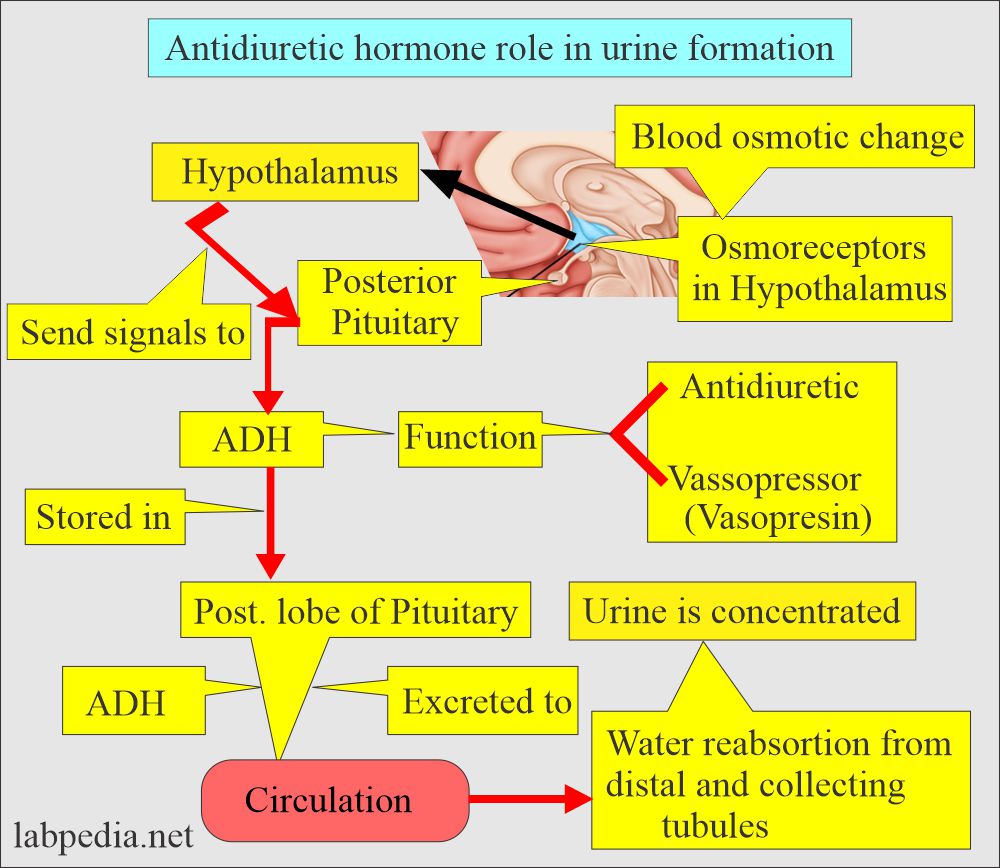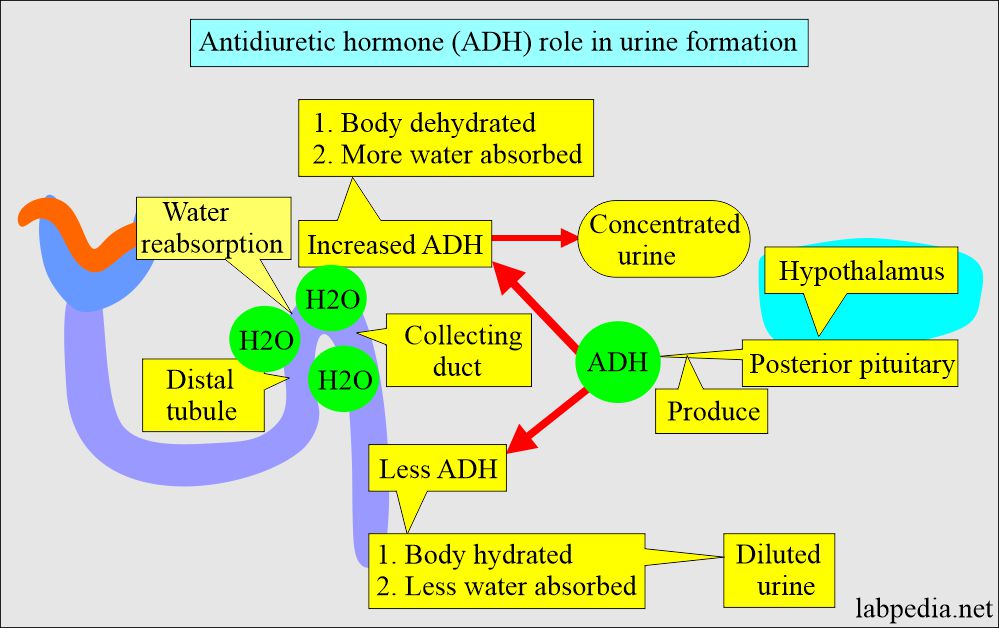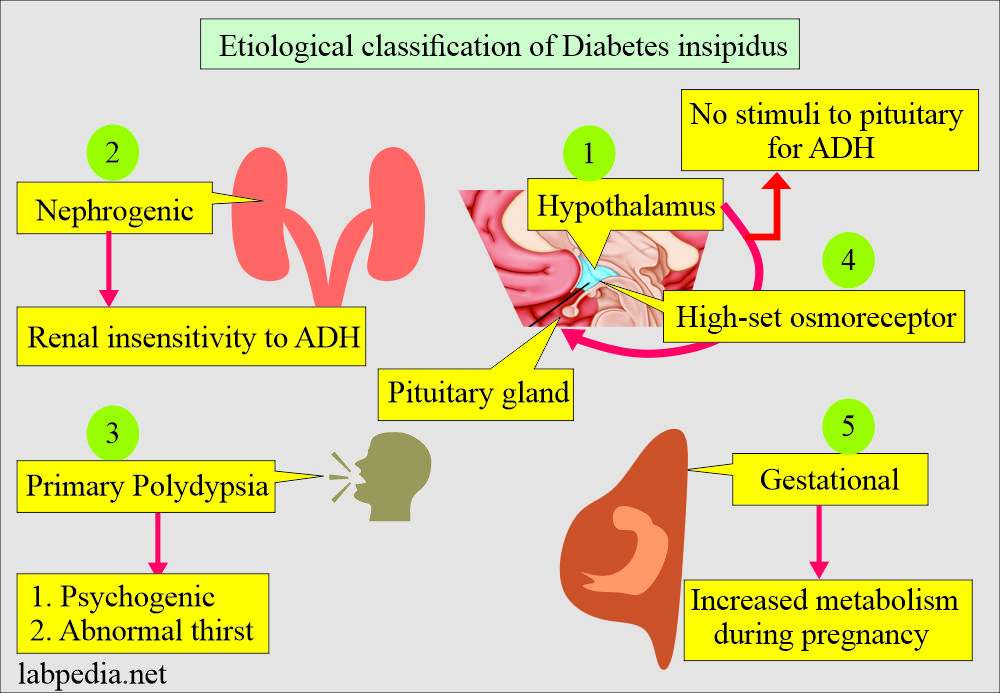Antidiuretic Hormone (ADH, Vasopressin, Arginine Vasopressin), Diabetes Insipidus
Antidiuretic Hormone (ADH)
Sample for Antidiuretic Hormone (ADH)
- This test is done on the venous blood sample (Tube is prechilled).
- Plasma with EDTA is needed.
- Take the blood when a patient is in a sitting position and calm.
- Put the sample on ice.
- Or collect the sample in prechilled vials.
- Separate plasma immediately in the refrigerated centrifuge and freeze at -20 °C.
Purpose of the test (Indications) for Antidiuretic Hormone (ADH)
- ADH is done in patients with diabetes insipidus.
- Advised in a patient with polyuria or polydipsia.
- This is also advised in hyponatremia.
- For the diagnosis of ectopic ADH production.
- This is advised in SIADH (syndrome of inappropriate antidiuretic hormone secretion).
- This is also advised in psychogenic water intoxication.
Precautions for Antidiuretic Hormone (ADH)
- Avoid glass syringe or collection tube, which causes degradation of the ADH.
- Avoid dehydration, hypovolemia, and stress, which may lead to increased ADH levels.
- Avoid overhydration and hypervolemia, which may decrease the ADH level.
- The use of a glass syringe or collection tube causes degradation of the ADH.
- Drugs like acetaminophen, cholinergic drugs, barbiturates, nicotine, estrogen, oral hypoglycemic agents, diuretics (thiazide), narcotics, and tricyclic antidepressants will increase ADH.
- Drugs like alcohol, morphine antagonists, Dilantin, and beta-adrenergic agents will decrease the ADH level.
- The recent history of radioisotopes gives the wrong result.
Definition of Antidiuretic Hormone (ADH):
- ADH, also called Vasopressin (or arginine Vasopressin), produced under the center’s influence in the anterior hypothalamus and stored in the posterior pituitary gland, is excreted into the blood circulation.
- ADH is considered one of the plasma volume regulators of its ability to concentrate the urine via its action on the renal distal and collecting tubules by water reabsorption.
- The osmolarity of the extracellular fluid control ADH release.
- Increased osmolarity stimulates the osmoreceptors in the hypothalamus, which stimulates the ADH release.
The major functions of Antidiuretic hormone (ADH):
- When ADH activity is present, then a small volume of concentrated urine is excreted.
- When ADH is absent, then a large volume of dilute urine is excreted.
- ADH Maintains water homeostasis.
- There is water reabsorption by the kidney, and urine is concentrated.
- ADH in sufficient quantity induces generalized vasoconstriction that leads to an increase in arterial blood pressure.
- ADH releases more water reabsorbed from the distal and collecting tubule; it increases water reabsorption and leads to concentrated urine and more water in the blood circulation.
- ADH decreased level, and less water was reabsorbed (water was allowed to be excreted), leading to dilute urine and hemoconcentration.
Antidiuretic hormone (ADH) release is stimulated by:
- The increase in serum osmolality.
- Blood osmotic changes, like concentration and dilution, act on osmoreceptors in the hypothalamus.
- The decrease in intravascular blood volume (blood volume changes).
- Higher secretion at night and with erect posture and exercise.
- Physical Stress, surgery, and even anxiety.
- Neural influences like pain.
- Certain drugs like morphine and alcohol.
The most important syndromes associated with ADH are:
- Diabetes inspidus.
- Inappropriate ADH syndrome.
Syndrome of inappropriate ADH secretion (SIADH):
- It is associated with high serum ADH levels.
- There is water retention due to the secretion of ADH when not secreted in normal conditions.
- The Criteria for SIADH are the secretion of the ADH despite the hemodilution, decreased serum osmolality, or both.
- Mostly these patients have no edema.
Diagnosis of SIADH and its characteristic features:
- Hyponatremia.
- Continued renal excretion of the Na+ despite the hyponatremia.
- Serum hypoosmolarity.
- Urine osmolality shows a significant degree of concentration instead of what one would expect to have dilute urine.
- No evidence of blood volume depletion.
- There is a normal renal and adrenal function that will differentiate from other causes.
- These criteria will demonstrate that ADH is secreted despite the hemodilution, decreased serum osmolality, or both.
- Most of these patients do not have edema because interstitial fluid expansion is usually moderate in degree.
- The water load test means ADH suppression differentiates the SIADH from the other causes of hyponatremia and/or edematous conditions.
- Measure urine and serum osmolarity.
- Patients with SIADH secrete very little or none of the water overload.
- Urine osmolarity will never be <100 mmol/kg
- The urine/serum ratio is >100.
- Measure urine and serum osmolarity.
- The treatment of the choice for SIADH is the restriction of fluid intake, which may provide some evidence of this syndrome.
Paraneoplastic syndrome:
- It is seen in ectopic production of the ADH, like carcinoma of the lung, thymus, lymphoma, carcinoma of the pancreas, leukemia, urinary system, and intestine.
- This condition may also be seen in pulmonary tuberculosis and pneumonia.
- Other conditions are CNS tumors, infection, and trauma.
Diabetes Insipidus
Definition of diabetes inspidus:
- This is a syndrome characterized by hypotonic polyuria.
- Diabetes insipidus is a chronic condition accompanied by a large volume of hypotonic urine caused by an inability to concentrate the urine due to a lack of ADH secretion or production.
- Diabetes insipidus is characterized by:
- Abnormally increased urine output.
- Increased fluid intake.
- Often accompanied by thirst.
- This is because of the absence of the ADH effect either due to
- Impaired or failed secretion from the pituitary gland (neurogenic).
- Or no response by the end organ, kidneys (nephrogenic).
- This may be seen in a person with psychogenic polydipsia or compulsive water intake may present as diabetes insipidus patients.
- This is called diabetes, but it has no relation to diabetes mellitus, where the polyuria is hypertonic due to the overexcretion of glucose in the urine.
Classification of diabetes insipidus:
The possible etiological classification is as follows:
- Neurogenic, where the hypothalamus cannot produce ADH from the pituitary gland.
- Renal is where the end-organ inability to respond normally to ADH.
- Primary polydipsia may be psychogenic or abnormal thirst mechanism.
- Temporary overpowering of vasopressin system. A large quantity of water is ingested, sometimes called primary diabetes inspidus.
- Gestational Diabetes inspidus, where there is increased metabolism of ADH.
- High-set osmoreceptors.
- ADH is inadequate OR
- When kidneys are not responsive to ADH stimulation.
- The patient excretes a large volume of water in the urine.
- There is hemoconcentration, and patients feel thirsty.
Another Classification of Diabetes Insipidus:
- Neurogenic Diabetes insipidus. It is caused by:
- Trauma, tumor, or inflammation of the brain (Hypothalamus).
- ADH level is low.
- Surgical ablation of the pituitary gland or mass lesion.
- X-linked recessive familial form.
- Nephrogenic diabetes insipidus. It is caused by:
- Renal collecting system unresponsiveness to ADH.
- ADH level is raised.
- Hypercalcemia.
- Hypokalemia.
- A very low protein diet.
- Lithium therapy.
- The release of long-standing obstruction.
- Aging may be associated with partial nephrogenic diabetes inspidus.
- Renal collecting system unresponsiveness to ADH.
Diabetes insipidus criteria are:
- There are polyuria and polydipsia.
- Low urine osmolarity.
- Hypernatremia.
Diagnosis of Diabetes inspidus:
- Before starting the test for the diabetes insipidus, advise the following tests with unrestricted diet and water intake:
- Urine output >2000 mL/day.
- Urine is hypotonic with osmolality <300 mosm/kg body weight/day (range is 200 to 300 mosm/kg).
- The above findings favor the diagnosis of diabetes insipidus.
- In that case, measure solute contents /day.
- If the solute excretion is <20 mosm/kg/day, it indicates definitely diabetes insipidus.
- The D/D of polyuria excludes:
- Osmotic diureses like glucose, mannitol, and sodium chloride.
- Diuretics therapy.
- Severe chronic renal disease.
- After acute tubular necrosis.
- After renal transplantation.
- Pregnancy-induced.
- Hypercalcemia.
- Hypokalemia.
- Drugs like lithium, chlorpromazine, and thiazide.
- Sickle cell disease.
- Water deprivation or dehydration test:
- Before starting the test to find the etiology, it is recommended that note the following:
- 24-hour urine volume.
- The osmolality of urine.
- Amount of solute excreted in the urine.
- Serum sodium, potassium, calcium, and osmolality without any restriction of the diet or water are recorded.
- When Results show the following value, then think about Diabetes Inspidus:
- Excess urine output.
- Urine is hypotonic.
- Stop all medications which can influence the release of ADH before 24 hours and during the test like:
- Alcohol.
- Tobacco.
- All caffeine-containing drinks.
- This test is done by overnight deprivation of water.
- Record the serum osmolality and sodium levels before and after the administration of vasopressin.
- It is followed by the ADH (vasopressin) administration. Inject subcutaneously either 1 µg of desmopressin ( a synthetic analog of ADH), or 5 IU of ADH (vasopressin).
- Collect urine samples for 30, 60, and 120 minutes.
- Result:
- Urine osmolality after the injection of ADH is less than 50% higher than the baseline urine osmolality favors diabetes insipidus (nephrogenic type).
- If there is an increase equal to or greater than 50%, favor diabetes insipidus, neurogenic type.
- In a healthy person, urine osmolarity increases during water deprivation.
- Administration of vasopressin has to additional effect on urine concentration.
- In the case of neurogenic diabetes inspidus:
- No urine concentration in response to water deprivation.
- When vasopressin is given, then urine osmolarity increases.
- The Serum ADH level is low.
- While in the case of nephrogenic diabetes inspidus:
- Urine cannot be concentrated in either case.
- There is no rise in urine osmolality after water deprivation or after vasopressin administration.
- The Serum ADH level is high.
- The standard diagnostic test for Diabetes Insipidus is the water deprivation test.
- ADH presence leads to a small volume of concentrated urine.
- ADH absence leads to a large volume of diluted urine.
ADH release is stimulated by:
- Increase in serum osmolality.
- A decrease in intravascular blood volume.
- Sleep
- At night.
- In erect position.
- With pain.
- In surgery.
- Physical Stress.
- High level of anxiety.
- Exercise.
- Chemical agents like catecholamine, opiates, nicotine, anesthesia drugs, barbiturates, and angiotensin ii.
ADH release is inhibited by:
- The increase in plasma volume.
- The decrease in plasma osmolality.
- Alcohol.
- Phenytoin.
- Glucocorticoids
Normal Antidiuretic Hormone (ADH):
Source 2
- 1 to 5 pg/ mL or <1.5 ng/L.
- Or < 2.5 pg/mL.
ADH suppression test (water load test):
- 65% of the water load is excreted in 4 hours.
- 80% of the water load is excreted in 5 hours.
- Urine osmolality in the second hour = ≤100 mmol/kg
- Urine to serum (U/S) osmolality ratio = >100
- Urine specific gravity = <1.003
Another source
- 2 to 8 pg/mL
Source 4
- <2.5 pg/mL or <2.3 mmol/L
Increased Antidiuretic Hormone (ADH) level is seen in:
- Hyperfunction of the ADH state gives rise to the Syndrome of inappropriate antidiuretic hormone secretion (SIADH).
- There is a sustained release of ADH in the absence of a known cause.
- Central nervous system diseases like tumors or infection.
- Pulmonary tuberculosis or pneumonia.
- Lung cancer (ectopic ADH).
- Nephrogenic diabetes insipidus due to renal diseases.
- Myxedema.
- Physical stress like pain and trauma.
- Hypovolemia.
- Dehydration.
- Acute and intermittent porphyria.
- Guillain-barre syndrome.
Decreased Antidiuretic Hormone (ADH) level is seen in:
- Hypofunction ADH gives rise to a polyuric state.
- Urine output is more than 2.5 L/day.
- Nephrogenic diabetes insipidus.
- Nephrotic syndrome.
- Water intoxication (psychogenic polydipsia).
- Surgical ablation of the pituitary gland.
- Hypervolemia.
- Decreased serum osmolality.
- This polyuric state is divided into:
- Hypothalamic diabetes inspidus.
- Nephrogenic diabetes inspidus.
- Psychogenic polydipsia.
Questions and answers:
Question 1: What will be sodium in diabetes insipidus?
Question 2: What are the types of diabetes insipidus?




